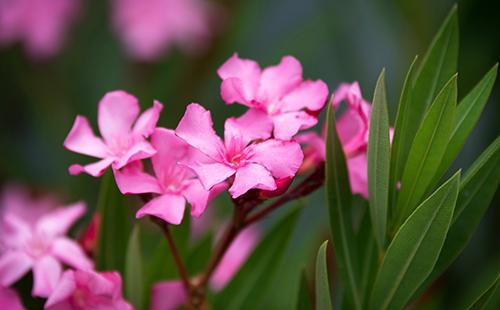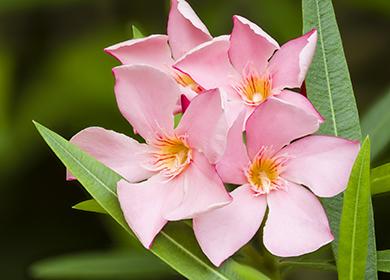The content of the article
Evergreen perennial plant with fragrant bright flowers and elongated leathery leaves. It grows naturally in the tropical zones of Portugal, in Morocco and China.
Description and Features
Evergreen tall shrub of the kutra family. Leaflets up to 15 cm long, leathery, with prominent light veins, similar to willow. It blooms very beautifully. Buds up to 6 cm, collected in lush inflorescences. The color is often pink or white. There are varieties with red, yellow and two-tone flowers. It blooms from early summer to mid-autumn. Among modern hybrid varieties, there are varieties with beautiful double flowers. Sometimes an oleander is called a pink laurel. It grows quite large.
Varieties
All species of oleander known in room culture are very decorative. They differ in the shade of flowers, size, leaf color.
- Oleander ordinary. High variety. In favorable natural conditions, it can reach 4 m. The leaves sit on short petioles, have a linear elongated shape. The outer side of the leaf is green, the inner is light. Inflorescences are large, lush. Flowers of pink or reddish hue. The aroma is pleasant, flowering continues throughout the summer and early fall.
- Oleander white. Very easy to grow plant. Often used for landscaping offices. Without cropping grows up to two meters. Flowering begins in the summer, ends in late autumn.
- Terry pink oleander. It forms a neat little bush with delicate terry flowers of a pink tone.
- Oleander yellow. It features bright yellow flowers resembling bells. Inflorescences are racemose, tender peach color. Blooms all summer and half autumn. An interesting feature is that several plants grow from one seed.
Oleander Care: Basic Rules
All oleanders are relatively unpretentious. They grow rapidly, and under good conditions, willingly bloom. When growing oleander, it is recommended to adhere to a number of rules.
- Temperature. In the summer, keep at normal room temperature from 20 to 25 ° C. In winter, it is advisable to lower the temperature to 10-15 ° C. If it is not possible to create suitable conditions, the room is often aired.
- Lighting. Need bright lighting. He is not afraid of the sun - it can be placed on the southern windowsill or transferred to the balcony in the summer. The lack of light in winter is compensated by artificial lighting.
- Watering. The watering regime depends on the time of year, the conditions of detention. In summer, when growing in a sunny place, they make sure that a small amount of water always remains in the pan.The oleander loves moisture, watered it immediately after the soil surface dries up. In winter, the frequency and intensity of irrigation is reduced, they monitor the level of soil moisture - it should not be too damp.
- Humidity. Gratefully responds to systematic spraying. In the heating season and hot summer days sprayed daily. Periodically bathe under a warm shower.
- Top dressing. Use complex fertilizers for flowering plants. Sometimes you can feed organic - mullein, nettle infusion. The intervals between dressings - two weeks. To exclude a burn of the roots, fertilizers are applied only after watering.
- The soil. Soil is prepared from an equal amount of turf, coarse sand, humus, sheet land, peat.
- Transfer. Young specimens are transplanted annually into a larger diameter pot. It is enough to transplant adult bushes every two to three years. The root system is sensitive, so they try not to disturb it - they transplant it by transshipment.
Why does not bloom
If the oleander does not bloom, then serious care mistakes have been made. There may be several reasons.
- Warm wintering. To actively book flower buds, the oleander needs coolness and good lighting. In warmth, the flower continues to grow, but does not lay flower buds.
- Big pot. In too spacious pots, the root system begins to actively develop. The plant is gaining green mass, flowering is inhibited.
- Lack of moisture. Systematic drying of an earthen coma, irregular watering adversely affect flowering.
- Lack of nutrition. Due to the rapid growth with rare top dressing, a nutrient deficiency occurs.
- No cropping. Flower buds are laid only on the tops of young shoots. Without pruning, flowering stops or is very scarce.
Breeding methods
Growing oleander at home is possible from seeds and cuttings. More often, the oleander is propagated vegetatively. Growing from seeds is a long and laborious process.
Seeds
Description. Seeds very quickly lose their germination. It is not recommended to store the collected seeds - it is better to plant them immediately.
Procedure
- Pre-seeds are soaked in water with the addition of potassium permanganate for about half an hour. A couple more hours are kept in water without additives.
- Seeds are sown in a light substrate containing coal, sand or vermiculite. No need to close up.
- The landing container is covered with polyethylene or glass on top, placed in a warm, bright place. The temperature should not fall below 18 ° C.
- The appearance of the first shoots is expected in 7-10 days.
- The film is removed from the container, the seedlings continue to be kept in a warm, bright place.
- They monitor the moisture of the soil - even its short-term drying out is not allowed.
- At the stage of four true leaves, oleander seedlings can be planted in separate containers.
Cuttings
Description. It is much easier to propagate the oleander by cuttings. Cut them in spring or autumn.
Procedure
- Cut tops of shoots up to 10 cm long.
- Slices sprinkled with coal powder, cuttings left to dry for an hour.
- Coarse sand and highly crushed coal are mixed as a substrate. Can be rooted in perlite.
- Cuttings are kept in conditions of moderate humidity, a temperature of about 20 ° C, in the light.
- Cuttings produce roots in about a month, sometimes a little earlier.
- You can put the stalk in water with the addition of activated carbon. To accelerate the formation of roots, the lower part of the handle is treated with heteroauxin or another root formation stimulator.
Air lay
Description. Less commonly used reproduction by layering. To obtain air layers, choose healthy, strong shoots.
Procedure
- The ring of the cortex is cut, the cut is treated with a root stimulator, wrapped with wet sphagnum and polyethylene.
- Sphagnum periodically moisturize, do not allow its complete drying out.
- After the appearance of the roots, the shoot is cut off and planted in a small pot with light nutritious soil.
- At first, layering requires careful maintenance with maintaining a stable soil moisture. With the slightest drying of the soil, still weak roots can die.

Pests
Under adverse conditions, oleander is attacked by pests. Most of the problems shieldsred spider mite andmealybug. Signs of defeat by these pests and methods of combating them are described in the table.
Table - Oleander Pests
| Pest | Signs | Wrestling |
|---|---|---|
| Red spider mite | - Thin cobweb; - marbling of leaves; - yellowing and falling of leaves; - slowdown | - Removal of affected leaves; - washing with soapy water; - acaricide treatment |
| Shield | - Spots on the leaves; - plaques on the stems; - sticky drops on new shoots | - Wipe the affected leaves with alcohol or kerosene; - pruning of shoots damaged by pests; - treatment with the insecticide "Actellic" |
| Mealybug | - Yellowing, falling leaves; - whitish, wool-like plaque | - Trimming of the affected parts; - treatment with a swab moistened with alcohol; - treatment with carbafos (up to 40 drops per liter of water) |
Other growing problems
Diseases are rare. More often, loss of decorativeness, weakening of the plant is associated with pests or care errors. The main problems that can be encountered when growing oleander are summarized in the table.
Table - Problems in growing oleander
| Problem | The reasons | Solution to the problem |
|---|---|---|
| Oleander leaves turn yellow | - Drying of the soil; - problems with the roots; - pests | - Inspect for pests; - adjust the watering mode |
| Dark needles form on new shoots | - Feature of the structure | - nothing to do |
| No bloom | - Warm content in winter; - lack of lighting and water; - no cropping | - Correct the care regimen; - regularly cut |
| The buds formed, but did not open | - Oleander is cold | - Rearrange the flower to heat |
| The tips of the leaves dry | - Too dry air | - Regularly sprayed; - increase humidity in the room |
| Leaves fade, color fades | - Problems with the root system | - Transplanted with the removal of rotten roots; - treated with fungicides |
Since it is not very difficult to take care of an oleander, it is quite possible to create conditions favorable for its growth in the apartment. The long flowering period, high decorativeness make it a welcome flower in the collection of any grower.

